Eagle Guide
by Martin Willey
The Eagle is a space shuttle craft used between the Earth and the Moon, for crew and materials (including nuclear waste). It is capable of operations in space, over the lunar surface, and in planet atmospheres.
Space Brain establishes that the Eagle Transporter and passenger pod has a combined mass of 328 tons. It is considerably heavier (by a factor of ten) than a real NASA lunar landing craft of comparable size, and the Eagle does seem to be remarkably strongly built as it survives crash landings with far less damage than a real aircraft or spacecraft would.
It is impossible to determine the exact size of the Eagle as the interior sets and the SFX model have inconsistent dimensions (see Eagle Scale for a detailed discussion). The approximate length is in the 23-31 metre range depending on which errors (internal sets or external model) are neglected.
In War Games we learn the top speed of Eagles is half that of Hawks at 14.2. In Ring Around The Moon, an Eagle's speed increases from 7.5 to 9.2 in a forcefield; in The A B Chrysalis the explosion boosts an Eagle to a speed of 804. Whatever the speed, flight times are very short, sometimes just minutes.
The Eagles carry "anti gravity screens" (Black Sun) / "anti gravity shields" (Ring Around The Moon). The anti gravity shield is "aimed to reduce gravitational pull from another planet" (Space Brain). This presumably explains how the Eagle is capable of extended atmospheric flight despite its non-aerodynamic shape. The screens also generate a normal 1 G gravity field inside the Eagle (War Games establishes that the compensator strength can be adjusted) ; the field can also be extended to docked spacecraft (Earthbound). The dialogue in Brian The Brain and The Exiles also suggests the anti-gravity screens can be projected onto other remote objects in space, pushing or pulling them off course. They can are also used as a countermeasure against unspecified "force fields" produced by aliens in War Games and Ring Around The Moon. However, the anti-gravity screen apparently does not shield the crew against the G forces produced by rapid acceleration/deceleration (The Metamorph, Devil's Planet, Ring Around The Moon).
The "main motors" are "atomic" (The Lambda Factor, where we see a "starboard atomic engine" -possibly one of the four landing rockets- being tested). They are powered by "nuclear fuel cells" (Space Brain). The Eagle also carries secondary "retro" thrusters (War Games). It is not clear if these engines are nuclear or chemical (the Voyager ship has chemical landing rockets). The tanks of briassic acid that are smashed in The Last Sunset may house propellant for the chemical rockets (nitric acid is a common storable chemical rocket propellant). The landing leg pods presumably contain the main propellant tanks (Eagles are refuelled in space in Space Warp and The Rules Of Luton), however, the size of the tankage seems much too small for (e.g.) a nonstop flight from the lunar surface to Earth and back (Another Time Another Place). Clearly, the anti-gravity screens dramatically extend the Eagle's performance envelope. Anti-gravity is way beyond current technology capabilities -- perhaps the technology was obtained from extraterrestrial sources?
The primary attitude control system consists of reaction thruster sets mounted on the side of the four landing pods. Each reaction thruster has four small rocket nozzles that closely resemble those of the NASA Apollo lunar spacecraft.
Nuclear batteries are carried although Eagles also have "solar batteries" (The A B Chrysalis) which likely implies batteries charged by solar photovoltaic panels (perhaps mounted on top the passenger pod?) can produce power in an emergency. Power packs are stripped from the Eagles for use in Alpha in Black Sun and One Moment Of Humanity.
Main Mission tracks Eagles using radar (Space Brain, The Last Sunset) and we can logically assume the Eagle carries a radar for rendezvous and docking with other spacecraft as well as landing altitude measurement (the four dish like objects on the Eagle command module look very much like rendezvous radar antennas). A radar image is shown on the cockpit screen in Dragon's Domain. Navigation lights on the legs were seen only in Ring Around The Moon.
The Eagle computer system apparently utilises the same mid-1980s technology as that of the Voyager (Voyager's Return) and Uranus (Death's Other Dominion) probes.
The Eagle "on-board computer" is presumably located in the cockpit. It stores data from e.g. radiation and remote sensors (Collision Course; Matter Of Life And Death) and also performs navigational calculations (Space Warp, The AB Chrysalis, The Rules of Luton) .It continuously monitor the health of Eagle subsystems (Seed of Destruction). It can also act as an autopilot during landings (Death's Other Dominion) and presumably controls the Eagle when it is operating in unmanned "robot" mode such as in The Metamorph. On laser equipped Eagles, the on-board computer normally provides target ranging and tracking information although there is a human override function (Alpha Child). The on-board computer can also estimate the trajectory of external objects based on input from the Eagle sensors (Catacombs of the Moon).
A standard "X5 computer" is additionally carried inside the passenger pod on some exploration missions. It serves as a medical monitor in All That Glisters and also seems to provide additional navigation information in The A B Chrysalis. In addition, the Eagles normally use navigation data transmitted by the Moonbase Alpha main computer (e.g. The Seance Spectre). Although the spacecraft can function without assistance from Alpha main computer, it cannot be flown without the on-board computer (Brian The Brain).
The Eagle computer has a voice in All That Glisters and The Mark Of Archanon, but this feature is rarely used. The crews issue commands by pushing buttons and levers while the computer displays information using the CRT screens and system status lights on the control panels.
Only some Eagles have "interstellar frequency" (Collision Course). This supposedly means they can normally only communicate with Alpha while within approx. one light-second [300,000km] of the Moon as all communication seems to be in real time. The Testament Of Arkadia establishes that the Eagle carries a radio transmitter but its power seems to be fairly limited (Arkadia is out of range although the Eagle round-trip time is only 30 hours; the landing party also seems to be unable to communicate with Alpha at a distance of 2.58 million miles in All That Glisters)
Remarkably, there does not seem to be any steerable parabolic dish antenna like those carried by current lunar and interplanetary spacecraft. The communications system also seems to be transmitting at high data rates since the normal means of communication is two-way audio/video (NASA's Apollo uplink was audio-only to reduce the size and power requirements of the spacecraft communications system). It is possible that a laser communications link is used instead, with the spacecraft firing laser beams precisely aimed at a large optical telescope on Alpha. A similar but smaller detector on the Eagle would detect more powerful laser pulses beamed by the Alpha space communications network. This technique (which will be demonstrated for the first time in 2010 by NASA's Mars Telecommunications Orbiter satellite) could support transmission rates of tens of billions of bits per second, i.e. similar to a fast broadband Internet connection. Extremely accurate pointing is required, however, and the laser beams would be blocked by dense clouds so it works less well if one of the communications stations is located on a planet with an atmosphere.
As on Moonbase Alpha, the main communications interface consists of 9" black and white cathode ray tube monitors. The two main CRT displays in the cockpit are frequently used as videophones by the Eagle crews. In Year Two, there is an additional centre console with side mounted CRT displays facing the pilot and copilot.
The passenger pod carries a similar system comprising one or two screens on the front bulkhead as well as in front of the seats (the X5 computer panels may also be used for this purpose, if installed). The Eagle communications system can also use the portable commlocks as an input device.
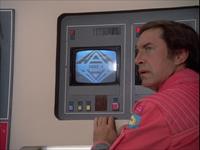
The most common passenger module communications console consists of twin B and W cathode ray tube screens. In New Adam New Eve, Koenig pushes the red button at far right to contact Command Centre. In Year 1 this communications console also has a hardcopy printout. In Mission Of The Darians, Bergman uses it for printing out information about the environmental conditions outside the Eagle.
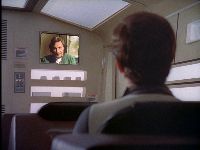
In Breakaway, Koenig's passenger module has a colour flatscreen instead.
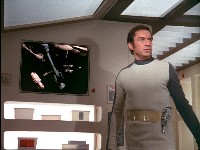
The portside flatscreen in Dragon's Domain has a red power switch. Koenig pushes it to display an external view of the alien spaceship graveyard.
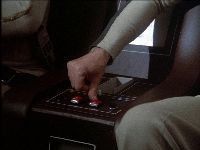
The front bulkhead screen controls are located between the passenger seats. The large red keys are apparently used for switching channels (incoming video conference call, external Eagle camera views etc.) as well as contacting the Eagle pilot. Shown here is the Breakaway configuration.
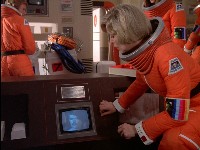
Additional small black and white screens in front of the seats perform the same functions. They are used briefly in Matter of Life and Death, Black Sun and Missing Link only.

If installed, the X5 computer large screens may also be used as videophones. The five buttons below the screen are apparently used for answering/ending incoming video calls. In Dragon's Domain, Koenig pushes the 1st and 4th buttons from left to answer video calls from Cellini and Morrow, respectively.
The Eagle can support a crew of two pilots. Up to eight passengers can be carried in the passenger pod. See Moonbase Procedures for crewing arrangements.
Black Sun establishes the Eagle life support system, with maximum supplies, can support a 6-crew for little more than a month (i.e. the same theoretical mission duration as NASA's current Extended Duration Orbiter space shuttles). Most Eagle missions only last a few days and stay within one light-second of Alpha [direct communication is always possible]; the limiting factor being life support. In exceptional cases, Eagles perform one month excursions at a distance of up to a few million miles from Alpha.
| Endurance/ Range | Episode |
|---|---|
| Crew of 6 can survive for 5 weeks (with maximum supplies) | Black Sun |
| Crew of 4 can survive for 14 days (with some supplies) | The Last Sunset |
| Reach a planet 2.58 million miles (4.15 million km) from the Moon (with only a 3-hour landing window). | All That Glisters |
| Crew of 1 can survive for 2 days (no supplies- routine mission?) | The Beta Cloud |
| Fuel for less than one million miles (1.5 million km) (rather meaningless in deep space, where spacecraft continue for millions of years unless their trajectories are perturbed by some outside event) |
Space Warp |
| Surface exploration teams survive for a month | The Seance Spectre |
| Travel Time | Episode |
|---|---|
| 5 minutes (lunar surface to safe distance from explosion- at least below the lunar horizon) | The Seance Spectre |
| 10 minutes (Moon to Psychon) | The Metamorph |
| 42 minutes (from moon to planet) | The A B Chrysalis |
| 3 hours (Tora to Moon) | The Seance Spectre |
| At least 3 hours- within 5 days of discovery. | Devil's Planet |
| Probably less than 4 hours (when oxygen leak is critical) | The Rules Of Luton |
| 18 hours to Blue Quadrant | The Mark Of Archanon |
| <48 hours round trip Moon to Earth | Another Time Another Place |
| 30 hours round trip Moon to Arkadia | The Testament Of Arkadia |
| 2.58 million miles (4.15 million km) in less than 2 days | All That Glisters |
| Within 2 days of discovery | The Immunity Syndrome |
Oxygen is supplied by a recycling system (The Seance Spectre; in this episode Maya refers to "oxygen starvation" but the most immediate danger in crewed spacecraft is really carbon dioxide build-up rather than oxygen deprivation. The basic principle of transforming carbon dioxide into oxygen is however correct).
Plastic containers are used for storing drinking water. Interestingly, NASA astronauts and Russian cosmonauts consume about 3 litres of water per person (half of it as drinking water, the rest as part of the food intake), so Alan Carter's estimate in The Last Sunset (Eagle 28 carries 30 gallons i.e. about 113 litres for a crew of four and a maximum mission duration of 14 days) sounds realistic.
The personal hygiene facilities, galley and toilet are supposedly located in the command module access corridor (probably behind the two side doors). Food is presumably stored, along with other equipment, in shelf containers in the passenger module and access corridors. Yellow food trays (actually 1970s "Hampa Pak" camper/picnic sets) are used in The Full Circle and other episodes. According to The Last Sunset, Eagle crews carry emergency "ration cubes" apart from the main food supply.
The Eagle cockpit windows have glare shields to protect the eyes of its crew (Catacombs Of The Moon). The Eagle has "radiation screens" (Collision Course) although they do not offer complete protection against radiation. Fraser mentions there is a "protective storm shield" as well (The Mark of Archanon) suggesting some sort of protection against micro-meteoroids.
Spacecraft electronic and life support systems produce heat which must be radiated into space. The Eagle landing pods and passenger module have rectangular panels which may be thermal radiators.
The Eagle's shape is non-aerodynamic and it does not carry thermal protection tiles like those of the NASA Space Shuttle to protect it against the searing heat caused by atmospheric friction during re-entry. Presumably, the spacecraft utilises its anti-gravity shields to slowly enter the upper atmosphere of a planet.
Access to the Eagle was by the passenger pod (docked or using steps), through a top hatch of a passenger module (seen in The Immunity Syndrome), through an escape hatch in the pilot section (used but not properly seen in Devil's Planet, and perhaps used to eject in War Games). In The Mark Of Archanon discussions include drilling through the cargo hatch, using the propulsion tubes (!), or via the inspection plates in the engine room.
The command module is detachable in emergency situations and consequently carries its own Guidance, Navigation and Control Subsystem, propulsion, thermal control, life support, power and docking systems (Dragon's Domain). It seems the passenger pod also can function independently on a planetary surface (Earthbound) but it is not clear if it is capable of independent spaceflight although there are four landing engines (the heavier booster pod carries six engines).
There is no airlock, and the entire passenger module must be de-pressurised. In Charlton color comics Vol 2 No 6 (1976), "Flotsam", the Eagle is broken. A co-pilot survives in a section of the ship that is pressurised within "plasti-seals" which are activated during a hull breach. The idea is resurrected in Moonbase Alpha Technical Operations Manual by Chris Thompson and Andrew Clements (2021), which describes "internal plastic-shields" (p140) to create air-pockets within the Eagle.
The Eagle carries a telescope and electronic camera for navigational purposes (Space Warp). At least some survey Eagles also carry powerful long range cameras for obtaining high resolution images from orbit (e.g. Devil's Planet).
The main payload is carried inside detachable pods in the centre section. See Eagle Pods and Eagle Equipment for details.
Eagles are numbered: Eagle 1, Eagle 2 and so on. Numbers higher than 12 are named by the individual numbers: 14 is "one four", 28 is "two eight". According to The Last Sunset, there are 27 "serviceable" Eagles on Moonbase Alpha in addition to their crashed Eagle (number 28). The highest number Eagle was 29 (Collision Course). Eagle 1 is the most commonly seen Eagle (in 32 episodes).
Copyright Martin Willey. Thanks to Marcus Lindroos